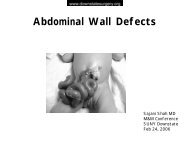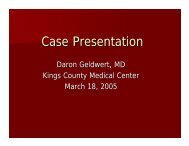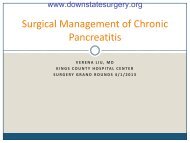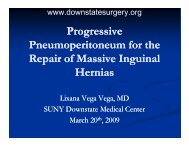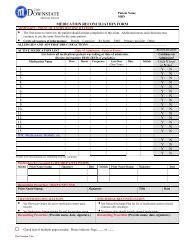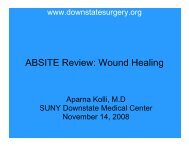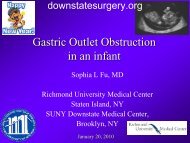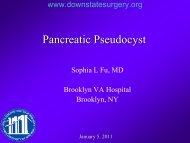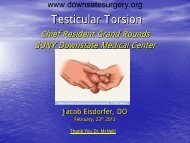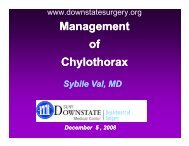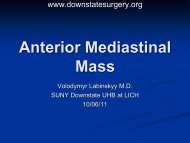Intractable Gastric Ulcer Disease - Department of Surgery at SUNY ...
Intractable Gastric Ulcer Disease - Department of Surgery at SUNY ...
Intractable Gastric Ulcer Disease - Department of Surgery at SUNY ...
You also want an ePaper? Increase the reach of your titles
YUMPU automatically turns print PDFs into web optimized ePapers that Google loves.
www.downst<strong>at</strong>esurgery.org<br />
<strong>Intractable</strong> <strong>Gastric</strong> <strong>Ulcer</strong><br />
<strong>Disease</strong><br />
Aaron M. Winnick, M.D.<br />
<strong>SUNY</strong> Downst<strong>at</strong>e Medical Center<br />
February 13, 2009<br />
3 ½ months…<br />
107 days…<br />
2,568 hours…<br />
154,080 minutes…until gradu<strong>at</strong>ion
<strong>Gastric</strong> <strong>Ulcer</strong><br />
www.downst<strong>at</strong>esurgery.org<br />
Case Present<strong>at</strong>ion<br />
• 44 yo Female<br />
• <strong>Intractable</strong> peptic ulcer disease x 2yrs<br />
• Tre<strong>at</strong>ed for H. pylori in the past<br />
• <strong>Gastric</strong> outlet t obstruction<br />
ti • IVDA<br />
• reported 100 lb weight loss over 9 months<br />
• PSH: Denied<br />
• Meds: Methadone, prevacid<br />
• Allergies: Codeine, ASA<br />
• Social: previous cocaine and heroine abuse<br />
• Endoscopies – stenosis <strong>at</strong> pyloris with<br />
scarring
<strong>Gastric</strong> <strong>Ulcer</strong><br />
www.downst<strong>at</strong>esurgery.org<br />
Case Present<strong>at</strong>ion<br />
• T 98 BP 110/65 P 95<br />
•Gen: AAOx3, thin, malnourished<br />
• HEENT: no JVD<br />
• CV: s1,s2, no murmurs<br />
• Lungs: CTA b/l<br />
• Abd: S<strong>of</strong>t, thin, nontender. No scars<br />
• Ext: equal palpable pulses b/l, no edema
<strong>Gastric</strong> <strong>Ulcer</strong><br />
www.downst<strong>at</strong>esurgery.org<br />
Case Present<strong>at</strong>ion<br />
• 10/06/08 -> OR<br />
• Findings- large, g, thick stomach; scarring around<br />
pylorus/duodenum<br />
• Truncal vagotomy<br />
• Antrectomy<br />
• Retrocolic loop gastrojejunostomy
<strong>Gastric</strong> <strong>Ulcer</strong><br />
www.downst<strong>at</strong>esurgery.org<br />
Case Present<strong>at</strong>ion<br />
• POD #1 – severe pain<br />
• Methadone SQ, Fentanyl<br />
• POD #3 – fl<strong>at</strong>us<br />
• POD #4<br />
– NGT removed, started on post-<br />
gastrectomy diet<br />
• POD #6- abdominal distention, post-op op ileus<br />
• Pain intermittent<br />
• Started on TPN<br />
• Refused Nasogastric tube
POD #6<br />
www.downst<strong>at</strong>esurgery.org
POD #7<br />
www.downst<strong>at</strong>esurgery.org
POD #9<br />
www.downst<strong>at</strong>esurgery.org
www.downst<strong>at</strong>esurgery.org
www.downst<strong>at</strong>esurgery.org
www.downst<strong>at</strong>esurgery.org
www.downst<strong>at</strong>esurgery.org
www.downst<strong>at</strong>esurgery.org
www.downst<strong>at</strong>esurgery.org
www.downst<strong>at</strong>esurgery.org
www.downst<strong>at</strong>esurgery.org
www.downst<strong>at</strong>esurgery.org
www.downst<strong>at</strong>esurgery.org
www.downst<strong>at</strong>esurgery.org
www.downst<strong>at</strong>esurgery.org
www.downst<strong>at</strong>esurgery.org
<strong>Gastric</strong> <strong>Ulcer</strong><br />
www.downst<strong>at</strong>esurgery.org<br />
Case Present<strong>at</strong>ion<br />
• POD #11 – NGT inserted, yielding 600cc feculent<br />
m<strong>at</strong>erial<br />
• POD #12 – Re-Explor<strong>at</strong>ion<br />
• Retrocolic loop gastrojejunostomy intact<br />
• Entire small bowel herni<strong>at</strong>ed through transverse<br />
mesocolon posteriorly<br />
• Mesentery, including root, herni<strong>at</strong>ed through<br />
defect
<strong>Gastric</strong> <strong>Ulcer</strong><br />
www.downst<strong>at</strong>esurgery.org<br />
Case Present<strong>at</strong>ion<br />
• OR…(cont)<br />
• Small bowel edem<strong>at</strong>ous, venous congestion<br />
• perfor<strong>at</strong>ion <strong>of</strong> distal ileum -> SBR with anastomosis<br />
• Gastrojejunostomy revised to antecolic Roux-en<br />
en-Y<br />
Gastrojejunostomy<br />
• Mesenteric defect closed<br />
• Pt transferred to PACU on pressors, intub<strong>at</strong>ed
<strong>Gastric</strong> <strong>Ulcer</strong><br />
www.downst<strong>at</strong>esurgery.org<br />
Hospital Course<br />
• POD #1<br />
Levophed and vasopressin. Acidosis corrected<br />
Transfused 4 units pRBC, started on broad-spectrum Antibiotics, TPN<br />
• POD#2 – WBC 26,000 (from 11,000)<br />
Adequ<strong>at</strong>e urine output<br />
• POD#3- weaned <strong>of</strong>f pressors<br />
• POD#4- WBC decreased to 11,000<br />
• POD#5- Febrile to 102F<br />
• POD# 7- foul smelling drainage from abdominal wound -> Succus<br />
• POD# 7- Tk Taken back to OR…
<strong>Gastric</strong> <strong>Ulcer</strong><br />
www.downst<strong>at</strong>esurgery.org<br />
Hospital Course<br />
• OR...(take 3)<br />
• Necrotic distal/terminal ileum <strong>at</strong> prior anastomosis site<br />
• Abdominal washout<br />
• Drainage with Malecot tubes x2 and Hemovac<br />
• Gastrojejunostomy anastomosis intact
<strong>Gastric</strong> <strong>Ulcer</strong><br />
www.downst<strong>at</strong>esurgery.org<br />
Hospital Course<br />
• POD # 1-20<br />
• Weaned from pressors<br />
• Extub<strong>at</strong>ed<br />
• Diet advanced<br />
• Drainage c<strong>at</strong>heters removed<br />
• Physical therapy<br />
• c/o persistent abdominal and db back pain
<strong>Gastric</strong> <strong>Ulcer</strong><br />
www.downst<strong>at</strong>esurgery.org<br />
Hospital Course<br />
• POD # 21-50<br />
• Pain management<br />
• Weaned from methadone<br />
• Wound care for stage II sacral decubitus ulcer<br />
• Physical therapy<br />
• Rejected from outside facilities due to past drug history<br />
• POD # 69<br />
• DVT left lower extremity – femoral -> popliteal veins<br />
• Started on anticoagul<strong>at</strong>ion
<strong>Gastric</strong> <strong>Ulcer</strong><br />
www.downst<strong>at</strong>esurgery.org<br />
Hospital Course<br />
POD # • 119…<br />
• Awaiting i discharge home when able to<br />
ambul<strong>at</strong>e independently…
<strong>Gastric</strong> <strong>Ulcer</strong><br />
www.downst<strong>at</strong>esurgery.org<br />
History <strong>of</strong> <strong>Gastric</strong> <strong>Ulcer</strong><br />
• 350 B.C. – Diocles <strong>of</strong> Carystos described existence<br />
• 131-201 A.D. – Cl<br />
Celsus and dGl<br />
Galen<br />
• 1586 – Marcellus Don<strong>at</strong>us <strong>of</strong> Mantua – described <strong>at</strong><br />
autopsy<br />
• 1880 – Theodor Billroth – First distal gastrectomy<br />
and gastroduodenostomy<br />
d t<br />
• 1885 – Billroth – First distal gastrectomy and<br />
gastrojejunostomy<br />
j t
<strong>Gastric</strong> <strong>Ulcer</strong><br />
www.downst<strong>at</strong>esurgery.org<br />
• Pyloroplasty<br />
History <strong>of</strong> <strong>Gastric</strong> <strong>Ulcer</strong><br />
• Heineke (1886) and Mikulicz (1888)<br />
• Jaboulay (1892) gastroduodenostomy<br />
• Finney (1902)<br />
• Subtotal Gastrectomy<br />
• Haberer and Finsterer (early 1900’s)<br />
• Truncal vagotomy (Transthoracic)<br />
• Lester Dragsteadt and Owen (1953)<br />
• Truncal vagotomy and hemigastrectomy<br />
• Farmer and Smithwick (1952)<br />
• Truncal vagotomy and antrectomy<br />
• Edwards and Herrington (1953)<br />
• Parietal cell vagotomy<br />
• Griffith and Harkins (1957)
<strong>Gastric</strong> <strong>Ulcer</strong><br />
www.downst<strong>at</strong>esurgery.org<br />
History <strong>of</strong> <strong>Gastric</strong> <strong>Ulcer</strong><br />
• Medical Management<br />
• Prior to 1980’s – antacids<br />
• 1980’s – H 2 receptor antagonists<br />
• 1990’s – Proton pump p<br />
inhibitors<br />
• Present –<br />
• H. pylori infection and peptic ulcer – PPI and eradic<strong>at</strong>ion<br />
• NSAID-induced ulcer – stopping medic<strong>at</strong>ion
<strong>Gastric</strong> <strong>Ulcer</strong><br />
www.downst<strong>at</strong>esurgery.org<br />
History <strong>of</strong> <strong>Gastric</strong> <strong>Ulcer</strong><br />
• Surgical Management<br />
• Prior to 1940’s – Subtotal gastrectomy<br />
• 1940-1950’s 1950’s – Vagotomy, antrectomy, pyloroplasty<br />
• 1960’s – Proximal gastric vagotomy<br />
• 1990’s – Laparoscopic vagotomy<br />
• Present – Life-thre<strong>at</strong>ening complic<strong>at</strong>ions <strong>of</strong> PUD<br />
• Bleeding<br />
• Perfor<strong>at</strong>ion<br />
• Obstruction
www.downst<strong>at</strong>esurgery.org<br />
An<strong>at</strong>omy <strong>of</strong> Stomach
www.downst<strong>at</strong>esurgery.org<br />
Arterial and Venous Supply
www.downst<strong>at</strong>esurgery.org<br />
Lymph<strong>at</strong>ic Drainage anage
<strong>Gastric</strong> <strong>Ulcer</strong><br />
www.downst<strong>at</strong>esurgery.org<br />
Innerv<strong>at</strong>ion<br />
• <strong>Gastric</strong> secretory and motor<br />
function<br />
• Intrinsic<br />
• Submucosal plexus (Meissner)<br />
• Myenteric plexus (Auerbach)<br />
• Extrinsic parasymp<strong>at</strong>hetic<br />
innerv<strong>at</strong>ion<br />
• Vagus nerve (Acetylcholine)<br />
• 75% <strong>of</strong> axons in vagal trunks are<br />
afferent<br />
• Nerves <strong>of</strong> L<strong>at</strong>arjet<br />
• “crow’s foot”<br />
• Criminal nerves <strong>of</strong> Grassi
<strong>Gastric</strong> <strong>Ulcer</strong><br />
www.downst<strong>at</strong>esurgery.org<br />
Physiology <strong>of</strong> acid secretion<br />
• 1 billion parietal cells<br />
• Stimul<strong>at</strong>ion by gastrin,<br />
acetylcholine, and histamine<br />
• Basal acid secretion<br />
2-5 mEq/hr<br />
• Si Stimul<strong>at</strong>ed acid secretion<br />
15-25 mEq/hr
<strong>Gastric</strong> <strong>Ulcer</strong><br />
www.downst<strong>at</strong>esurgery.org<br />
Evalu<strong>at</strong>ion<strong>of</strong>PUD<br />
<strong>of</strong> • Endoscopy<br />
• Radiologic tests<br />
• Plain CXR<br />
• Double contrast upper GI series<br />
• CT scan<br />
• MRI<br />
• EUS<br />
• Tests for H. pylori<br />
• Scintigraphy
<strong>Gastric</strong> <strong>Ulcer</strong><br />
www.downst<strong>at</strong>esurgery.org<br />
Helicobacter pylori<br />
• Serologic<br />
• Noninvasive<br />
• Sensiticity >80%, Specificity 90%<br />
• Urea bre<strong>at</strong>h test<br />
• Confirm<strong>at</strong>ory test after 4 weeks <strong>of</strong> therapy<br />
• Sensitivity and specificity 90-99%<br />
99%<br />
• Expensive<br />
• Histologic test<br />
• Sensitivity 80-100%, specificity >95%<br />
• Rapid urease test<br />
• Simple, invasive<br />
• Sensitivity i i 80-95%, specificity i 95-100%<br />
• False neg<strong>at</strong>ives
<strong>Gastric</strong> <strong>Ulcer</strong><br />
www.downst<strong>at</strong>esurgery.org<br />
Medical Management<br />
• Stop smoking<br />
• Avoid alcohol<br />
• Avoid idNSAIDS NSAIDS, Aspirin<br />
i<br />
• H. pylori (+) needs eradic<strong>at</strong>ion<br />
• First line triple therapy -> PPI + clarithromycin +amoxicillin<br />
• Second line tre<strong>at</strong>ment-> PPI + bismuth salts +<br />
Metronidazole + tetracycline<br />
• H. pylori (-)<br />
• H 2 receptor blocker<br />
• PPI<br />
• Sulcralf<strong>at</strong>e<br />
• Antacids
<strong>Gastric</strong> <strong>Ulcer</strong><br />
www.downst<strong>at</strong>esurgery.org<br />
Indic<strong>at</strong>ions for <strong>Surgery</strong><br />
• Bleeding<br />
• Perfor<strong>at</strong>ion<br />
• Obstruction<br />
• Intractability<br />
• Definition uncertain<br />
• Suspicion <strong>of</strong> malignancy<br />
• Failure <strong>of</strong> an ulcer to heal after 12 weeks <strong>of</strong> medical<br />
therapy
<strong>Gastric</strong> <strong>Ulcer</strong><br />
www.downst<strong>at</strong>esurgery.org<br />
Goals <strong>of</strong> <strong>Surgery</strong><br />
• Permit ulcer healing<br />
• Prevent or tre<strong>at</strong> ulcer complic<strong>at</strong>ions<br />
• Address the underlying ulcer di<strong>at</strong>hesis<br />
• Minimize i i postoper<strong>at</strong>ive digestive i sequela
<strong>Gastric</strong> <strong>Ulcer</strong><br />
www.downst<strong>at</strong>esurgery.org<br />
Principles <strong>of</strong> <strong>Surgery</strong><br />
• Acid reduction<br />
• Drainage<br />
• Resection and reconstruction<br />
• Omental p<strong>at</strong>ch<br />
• Oversewing
<strong>Gastric</strong> <strong>Ulcer</strong><br />
www.downst<strong>at</strong>esurgery.org<br />
Goals <strong>of</strong> <strong>Surgery</strong><br />
• Oper<strong>at</strong>ion for duodenal ulcer<br />
• Sectioning the vagus (Vagotomy)<br />
• Elimin<strong>at</strong>ing hormonal stimul<strong>at</strong>ion from antrum<br />
(Antrectomy)<br />
• Decreasing the number <strong>of</strong> parietal cells (<strong>Gastric</strong><br />
resection)
<strong>Gastric</strong> <strong>Ulcer</strong><br />
www.downst<strong>at</strong>esurgery.org<br />
Vagotomy<br />
• Elimin<strong>at</strong>es direct cholinergic stimul<strong>at</strong>ion to acid<br />
secretion<br />
• Makes parietal cells less responsive to histamine and<br />
gastrin<br />
• Abolishes vagal stimulus for release <strong>of</strong> antral gastrin<br />
• Truncal<br />
• Selective<br />
• Highly selective (Parietal Cell)
<strong>Gastric</strong> <strong>Ulcer</strong><br />
www.downst<strong>at</strong>esurgery.org<br />
• Truncal<br />
Acid reduction-Vagotomy<br />
• Reduces basal acid output 80%<br />
• Reduces stimul<strong>at</strong>ed acid 50%<br />
• Abolishes receptive relax<strong>at</strong>ion,<br />
Impairs tritur<strong>at</strong>ion<br />
• Need drainage procedures<br />
• Post-vagotomy syndrome<br />
• Selective<br />
• Preserves celiac and hep<strong>at</strong>ic<br />
branches<br />
• Still requires drainage<br />
• Parietal cell (Highly selective)<br />
• Denerv<strong>at</strong>es parietal cell mass<br />
• No need for drainage procedure
<strong>Gastric</strong> <strong>Ulcer</strong><br />
www.downst<strong>at</strong>esurgery.org<br />
Resection<br />
• Subtotal – Reduces basal acid secretion 75%, stimul<strong>at</strong>ed 50%<br />
• Emptying <strong>of</strong> solid and liquids more rapid<br />
• Antrectomy + vagotomy- remove cholinergic and gastrin stimulus<br />
• Basal acid secretion abolished; stimul<strong>at</strong>ed acid decreased 80%<br />
• Billroth I shows no functional difference compared to Billroth II
www.downst<strong>at</strong>esurgery.org
<strong>Gastric</strong> <strong>Ulcer</strong><br />
www.downst<strong>at</strong>esurgery.org<br />
Highly Selective Vagotomy vs<br />
Antrectomy vs. Drainage<br />
• Mortality and early morbidity highest for V+D, lowest for<br />
HSV<br />
• Avoids opening GI tract<br />
• Incidence <strong>of</strong> side effects similar for TV+A or TV+D, but<br />
significantly ifi lower for HSV<br />
• Recurrence r<strong>at</strong>es significantly lower for TV+A<br />
• TV +D had higher recurrence r<strong>at</strong>e and more unfavorable<br />
side effects
www.downst<strong>at</strong>esurgery.org
www.downst<strong>at</strong>esurgery.org
www.downst<strong>at</strong>esurgery.org<br />
<strong>Gastric</strong> ulcer
www.downst<strong>at</strong>esurgery.org<br />
Post-Gastrectomy<br />
Syndromes
<strong>Gastric</strong> <strong>Ulcer</strong><br />
www.downst<strong>at</strong>esurgery.org<br />
Antecolic versus retrocolic alimentary<br />
limb in laparoscopic Roux-en-Y gastric<br />
bypass: a compar<strong>at</strong>ive study.<br />
Escalona A, Devaud N, et.al. Surg Obes Rel<strong>at</strong> Dis 2007 Jul-Aug;3(4):423-7.<br />
• 754 p<strong>at</strong>ients undergoing LRYGB<br />
• 300 p<strong>at</strong>ients retrocolic technique<br />
• 454 p<strong>at</strong>ients antecolic technique<br />
• 36 p<strong>at</strong>ients (4.7%) required explor<strong>at</strong>ion for obstruction<br />
• 28 (9.3%) retrocolic vs 8 (1.8%) antecolic<br />
• Internal hernia in 24 vs 3 p<strong>at</strong>ients<br />
• Gre<strong>at</strong>er incidence <strong>of</strong> intestinal obstruction and internal hernia<br />
in retrocolic group
www.downst<strong>at</strong>esurgery.org
www.downst<strong>at</strong>esurgery.org
www.downst<strong>at</strong>esurgery.org
<strong>Gastric</strong> <strong>Ulcer</strong><br />
www.downst<strong>at</strong>esurgery.org<br />
Questions<br />
1) A 45 year-old man requires surgery for intractable<br />
duodenal ulcer. Which oper<strong>at</strong>ion best prevents<br />
ulcer recurrence?<br />
A) Subtotal gastrectomy<br />
B) Truncal vagotomy and pyloroplasty<br />
C) Truncal vagotomy and antrectomy<br />
D) Selective vagotomy<br />
E) Highly selective (Parietal cell) vagotomy
<strong>Gastric</strong> <strong>Ulcer</strong><br />
www.downst<strong>at</strong>esurgery.org<br />
Questions<br />
1) A 45 year-old man requires surgery for intractable<br />
duodenal ulcer. Which oper<strong>at</strong>ion best prevents<br />
ulcer recurrence?<br />
A) Subtotal gastrectomy<br />
B) Truncal vagotomy and pyloroplasty<br />
C) Truncal vagotomy and antrectomy<br />
D) Selective vagotomy<br />
E) Highly selective (Parietal cell) vagotomy
<strong>Gastric</strong> <strong>Ulcer</strong><br />
www.downst<strong>at</strong>esurgery.org<br />
Questions<br />
2) Advanced gastric outlet obstruction is<br />
characterized by which one or more <strong>of</strong> the<br />
following metabolic abnormalities?<br />
A) Hypochloremia and increased urinary chloride<br />
B) Hypokalemia secondary to urinary yp<br />
potassium loss<br />
C) Metabolic alkalosis with alkaline urine<br />
D) Metabolic alkalosis with acid urine<br />
E) Increased serum ionized calcium
<strong>Gastric</strong> <strong>Ulcer</strong><br />
www.downst<strong>at</strong>esurgery.org<br />
Questions<br />
2) Advanced gastric outlet obstruction is<br />
characterized by which one or more <strong>of</strong> the<br />
following metabolic abnormalities?<br />
A) Hypochloremia and increased urinary chloride<br />
B) Hypokalemia secondary to urinary yp<br />
potassium loss<br />
C) Metabolic alkalosis with alkaline urine<br />
D) Metabolic alkalosis with acid urine<br />
E) Increased serum ionized calcium
<strong>Gastric</strong> <strong>Ulcer</strong><br />
www.downst<strong>at</strong>esurgery.org<br />
3)<br />
Questions<br />
3) Which <strong>of</strong> the following st<strong>at</strong>ements is true regarding the<br />
surgical therapy <strong>of</strong> gastric ulcer?<br />
A) A type I ulcer <strong>at</strong> the incisura is effectively tre<strong>at</strong>ed by<br />
distal gastrectomy without vagotomy<br />
B) A type I ulcer <strong>at</strong> the incisura is preferably tre<strong>at</strong>ed by<br />
vagotomy and pyloroplasty<br />
l<br />
C) A type III pre-pyloric pyloric ulcer without obstruction is<br />
best tre<strong>at</strong>ed by parietal cell vagotomy<br />
D) Type II ulcers are best tre<strong>at</strong>ed by subtotal<br />
gastrectomy without vagotomy<br />
E) A type I ulcer on the lesser curve near the GE<br />
junction is best tre<strong>at</strong>ed by total gastrectomy
<strong>Gastric</strong> <strong>Ulcer</strong><br />
www.downst<strong>at</strong>esurgery.org<br />
3)<br />
Questions<br />
3) Which <strong>of</strong> the following st<strong>at</strong>ements is true regarding the<br />
surgical therapy <strong>of</strong> gastric ulcer?<br />
A) A type I ulcer <strong>at</strong> the incisura is effectively tre<strong>at</strong>ed by<br />
distal gastrectomy without vagotomy<br />
B) A type I ulcer <strong>at</strong> the incisura is preferably tre<strong>at</strong>ed by<br />
vagotomy and pyloroplasty<br />
l<br />
C) A type III pre-pyloric pyloric ulcer without obstruction is<br />
best tre<strong>at</strong>ed by parietal cell vagotomy<br />
D) Type II ulcers are best tre<strong>at</strong>ed by subtotal<br />
gastrectomy without vagotomy<br />
E) A type I ulcer on the lesser curve near the GE<br />
junction is best tre<strong>at</strong>ed by total gastrectomy
<strong>Gastric</strong> <strong>Ulcer</strong><br />
www.downst<strong>at</strong>esurgery.org<br />
Questions<br />
4) Which <strong>of</strong> the following is true about the<br />
postoper<strong>at</strong>ive effects on gastric emptying?<br />
A) Truncal vagotomy delays emptying <strong>of</strong> liquids<br />
id<br />
B) Truncal vagotomy acceler<strong>at</strong>es emptying <strong>of</strong> solids<br />
C) Parietal cell vagotomy does not affect gastric<br />
emptying<br />
D) Pyloroplasty l acceler<strong>at</strong>es emptying <strong>of</strong> solids<br />
E) Roux-en-Y gastrojejunostomy delays gastric<br />
emptying
<strong>Gastric</strong> <strong>Ulcer</strong><br />
www.downst<strong>at</strong>esurgery.org<br />
Questions<br />
4) Which <strong>of</strong> the following is true about the<br />
postoper<strong>at</strong>ive effects on gastric emptying?<br />
A) Truncal vagotomy delays emptying <strong>of</strong> liquids<br />
id<br />
B) Truncal vagotomy acceler<strong>at</strong>es emptying <strong>of</strong> solids<br />
C) Parietal cell vagotomy does not affect gastric<br />
emptying<br />
D) Pyloroplasty l does not affect emptying <strong>of</strong> solids<br />
E) Roux-en-Y gastrojejunostomy delays gastric<br />
emptying



